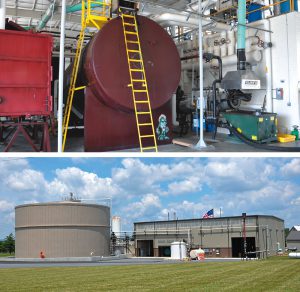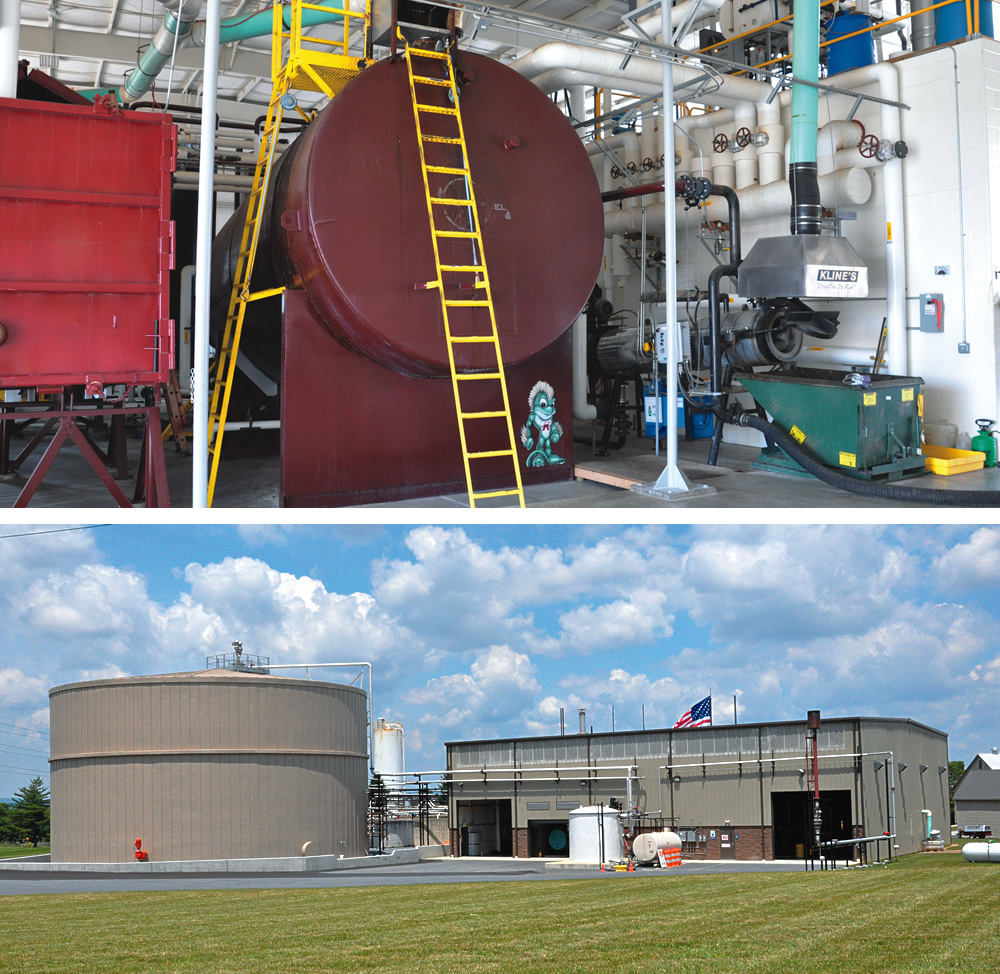What began as a septic tank pumping company in 1955 has expanded into a full-service wastewater treatment company — and renewable energy producer.
Barb Culton and Richard Mattocks
BioCycle September 2012, Vol. 53, No. 9, p. 41

The Food to Fuel project takes waste grease and oil from restaurants and food processing facilities and separates the oil from the water (left) to produce a heating oil. Residuals from that process, along with food waste and municipal sludge, are anaerobically digested in a 1.23 million gallon Biothane continuously-stirred reactor (below).
Kline’s has its own wastewater treatment facility for septic sludges, as well as permitted agricultural acreage to land apply some of the organic residuals it collects and treats, such as food processing waste. Research to create innovative ways to beneficially process the wide variety of waste streams the company handles began in 2007, leading to a three-phase waste to renewable energy initiative. Phase I, the Food to Fuel (F2F) project, successfully began in 2008. This system is capable of processing 50,000 gallons/day of grease trap and food processing waste rich in oils. The oil is extracted from the waste stream through steam extraction. In addition to fueling the boiler creating the steam, the oil is used to heat additional buildings on the Kline’s campus. The company has not purchased petroleum oil for heating for the past three years.
Research for Phase II also began in 2007. The goal of this project was to explore alternative methods to process residuals from Kline’s food processing customers. Kline’s teamed with Biothane, Inc., a Veolia Water Solutions & Technologies company, to evaluate anaerobic digestion of these residuals. The company handles every type of food waste, from sugars to proteins, as well as varying volumes. The challenge was to create a system capable of handling this wide variety of waste and the daily fluctuations.
Biothane reviewed years of food waste disposal records to identify patterns that could potentially impact digester and cogeneration performance. For example, there is almost no waste pick up on weekends and, depending on the waste, peaks during parts of the year and even peaks on certain days of the week. As operators of a wastewater treatment plant, Kline’s understood that the digester is a biological “creature” that has to be managed carefully to do what it is designed to do, including having the proper mix of feedstocks so that gas output is predictable. The quantities and qualities of wastes were identified and characterized to determine their methane power output potential.
CSTR Digester Operation
Biothane was awarded the contract in January 2011 to design a 1.23 million gallon Continuously Stirred Tank Reactor (CSTR) capable of handling 50,000 gallons/day with a 22 day hydraulic retention time. Construction began in June 2011; the digester began operating in April 2012. Primary feedstocks include food waste, residuals from the F2F process (grease trap and food processing) and municipal sludge. During the construction phase, Kline’s laboratory personnel tested each customer’s waste streams for parameters such as total solids, total volatile solids, chemical oxygen demand and biomethane potential (BMP) to categorize the waste streams according to strength. This information would be used to create a daily feed mix for the digester that would optimize methane production.
Incoming wastes are deposited in four underground tanks located in the processing building. Contents are metered into the digester, which is adjacent to the existing tank containment. Digestate is handled through Kline’s existing Sequence Batch Reactor (SBR) system. Sludge from the SBR is lime stabilized and processed through plate and frame presses, creating Class B biosolids that are land applied at approved farm sites in Lancaster County. Effluent is discharged to the local wastewater plant for additional treatment.
An average of 153 scfm of biogas is produced, which passes through an iron sponge scrubber to remove hydrogen sulfide. Conditioned biogas is sent to the Martin Machinery genset with a 710 kW Guascor engine. The first kWh was created on May 3, 2012 and by early August, Kline’s reached the first 1,000,000 kWh of electric production. Power is sold to the PJM grid, a regional transmission company. Enough electricity is generated on a daily basis to power the Kline’s campus as well as an additional 450 homes. Excess heat from the genset is captured and used to maintain the digester temperature at a steady 98°F.
Kline’s Services expects that close to 85 percent of the energy in the biogas will be used. At the moment, over 40 percent is captured in the form of electricity, and about 20 percent for digester heating needs. Another 20 to 25 percent will be dedicated to Phase III of the company’s Waste to Renewable Energy Project, which involves drying the biosolids created from its processes with excess heat from the anaerobic digester. The Class A biosolids can be used as a dry fuel substitute for electrical generation or as an alternative to chemical fertilizers.
Capital costs for the Phase I Food2Fuel project and the Phase II anaerobic digester were $2 million and $3.25 million, respectively. Kline’s received a $250,000 Pennsylvania Energy Development Authority grant to help fund the digester. The Food2Fuel facility is in its fourth year of operation and currently saves $32,000 a year in heating oil costs. Once the methane digester is running at capacity, the company anticipates reducing its $90,000 annual electricity bill, and receiving revenues from the excess energy sold back to the grid.
Barb Culton is an Environmental Manager with Kline’s Services in Salunga, Pennsylvania. Richard Mattocks is a Senior Environmental Scientist with Biothane in Camden, New Jersey.










